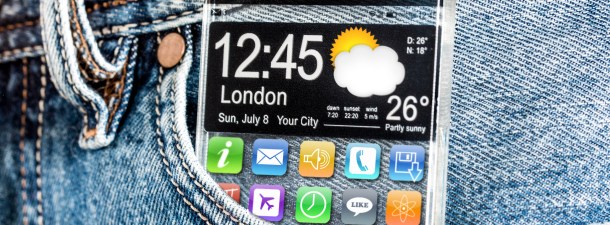In September last year, Apple introduced the iPhone 6 with the slogan ‘bigger than bigger’. Only eight years ago we couldn’t imagine a world where saying something like that about a mobile phone would be seen as a good thing. Suddenly, we not only don’t care, but it seems Apple is giving us exactly what we want and other manufacturers are following suit.
This sudden shift is happening because mobile content is redefining what is smartphone is really used for, but where is the limit to our newfound obsession with bigger being better?
Unless you are a committed hoarder, you may forget that the first iPhone was actually pretty small. At 3.5 inches, it seemed gigantic in 2007.
We have also seen huge outliers, phablets, which can reach screen sizes of 7 inches, blurring the line between devices primarily used for communication and devices for entertainment. When it comes to smartphone design these days, more real estate for content trumps everything else.
This brings up another point, something forgotten over time. We used to use mobile phones primarily to call people. No longer, a 2014 UK survey revealed making phone calls to be the 6th most important function on smartphones. Meanwhile a U.S. report states that nearly half of our time is spent on mobile phones consists of gaming and on Facebook. Making phone calls? Just a quarter of the time. The fact is is your gigantic screen helps you launch Angry Birds faster and see cat videos in near HD quality. Does it help your ability to actually call people? Probably not, but who cares when your big screen is helping you reach the next level on Candy Crush!
This transformation radically redefines what a phone is, more computer than communication device. So long as videos and gaming take top billing, those screens will get bigger.
So how do we accommodate our newfound mobile video obsession while still accommodating our phones inside our pockets?
The answer may be foldable phones. Expanding and retracting to be your phone at one moment, your tablet video screen the next, mobile phones will get more versatile. Samsung has hinted that foldable smartphones may arrive as soon as next year so people can get their video and gaming fix without sacrificing portability.
And for those who find holding a 7 inch screen up to your face the height of ridiculousness, help is on the way with wearable tech. Smartwatch calling and texting are still a bit awkward, but within a very short period time the technology will be there for the connections to be crisp and tethering to a phone unnecessary.
Take that together with increasingly smaller and more advanced earbuds like the Bragi Dash and you have a calling and texting solution that makes the phone part of your smartphone irrelevant.
Regardless of which innovations take hold, these changes will shift the focus of the more and more into its new role in your digital life, your primary personal computer. Big changes will keep coming to the way we use smartphones, and it doesn’t look it will involve calling our mothers more often.
We may never go back to the bricks from the 90s, but big smartphones are here to stay. After all, there’s so much good stuff to play and watch on your phone, and just like with TV, it’s always better on the big screen.









